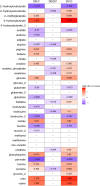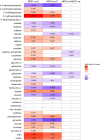Title NMR-based metabolic profiling provides diagnostic and prognostic information in critically ill children with suspected infection
- PMID: 33214628
- PMCID: PMC7677384
- DOI: 10.1038/s41598-020-77319-0
Title NMR-based metabolic profiling provides diagnostic and prognostic information in critically ill children with suspected infection
Abstract
Sepsis, defined as life-threatening organ dysfunction caused by infection is difficult to distinguish clinically from infection or post-operative inflammation. We hypothesized that in a heterogeneous group of critically ill children, there would be different metabolic profiles between post-operative inflammation, bacterial and viral infection and infection with or without organ dysfunction. 1D 1H nuclear magnetic resonance spectra were acquired in plasma samples from critically ill children. We included children with bacterial (n = 25) and viral infection (n = 30) and controls (n = 58) (elective cardiac surgery without infection). Principal component analysis was used for data exploration and partial least squares discriminant analysis models for the differences between groups. Area under receiver operating characteristic curve (AUC) values were used to evaluate the models. Univariate analysis demonstrated differences between controls and bacterial and viral infection. There was excellent discrimination between bacterial and control (AUC = 0.94), and viral and control (AUC = 0.83), with slightly more modest discrimination between bacterial and viral (AUC = 0.78). There was modest discrimination (AUC = 0.73) between sepsis with organ dysfunction and infection with no organ dysfunction. In critically ill children, NMR metabolomics differentiates well between those with a post-operative inflammation but no infection, and those with infection (bacterial and viral), and between sepsis and infection.
Conflict of interest statement
The authors declare no competing interests.
Figures





Similar articles
-
Interleukin-27: a novel biomarker in predicting bacterial infection among the critically ill.Crit Care. 2015 Oct 30;19:378. doi: 10.1186/s13054-015-1095-2. Crit Care. 2015. PMID: 26514771 Free PMC article. Clinical Trial.
-
Host gene expression signatures to identify infection type and organ dysfunction in children evaluated for sepsis: a multicentre cohort study.Lancet Child Adolesc Health. 2024 May;8(5):325-338. doi: 10.1016/S2352-4642(24)00017-8. Epub 2024 Mar 19. Lancet Child Adolesc Health. 2024. PMID: 38513681
-
Clinical application of Myxovirus resistance protein A as a diagnostic biomarker to differentiate viral and bacterial respiratory infections in pediatric patients.Front Immunol. 2025 Feb 19;16:1540675. doi: 10.3389/fimmu.2025.1540675. eCollection 2025. Front Immunol. 2025. PMID: 40046054 Free PMC article.
-
Plasma interleukin-6 concentration for the diagnosis of sepsis in critically ill adults.Cochrane Database Syst Rev. 2019 Apr 30;4(4):CD011811. doi: 10.1002/14651858.CD011811.pub2. Cochrane Database Syst Rev. 2019. PMID: 31038735 Free PMC article.
-
Interleukin-6 as a diagnostic marker for infection in critically ill patients: A systematic review and meta-analysis.Am J Emerg Med. 2019 Feb;37(2):260-265. doi: 10.1016/j.ajem.2018.05.040. Epub 2018 May 22. Am J Emerg Med. 2019. PMID: 29887194
Cited by
-
Immunometabolic signatures predict risk of progression to sepsis in COVID-19.PLoS One. 2021 Aug 30;16(8):e0256784. doi: 10.1371/journal.pone.0256784. eCollection 2021. PLoS One. 2021. PMID: 34460840 Free PMC article.
-
Multilevel omics for the discovery of biomarkers in pediatric sepsis.Pediatr Investig. 2023 Nov 21;7(4):277-289. doi: 10.1002/ped4.12405. eCollection 2023 Dec. Pediatr Investig. 2023. PMID: 38050541 Free PMC article. Review.
-
Double-Weighted Bayesian Model Combination for Metabolomics Data Description and Prediction.Metabolites. 2025 Mar 21;15(4):214. doi: 10.3390/metabo15040214. Metabolites. 2025. PMID: 40278343 Free PMC article.
-
Deciphering the molecular and cellular atlas of immune cells in septic patients with different bacterial infections.J Transl Med. 2023 Nov 2;21(1):777. doi: 10.1186/s12967-023-04631-4. J Transl Med. 2023. PMID: 37919720 Free PMC article. Review.
-
Features of Metabolites and Biomarkers in Inflammatory and Infectious Complications of Childhood Cancers.Biomedicines. 2024 Sep 14;12(9):2101. doi: 10.3390/biomedicines12092101. Biomedicines. 2024. PMID: 39335614 Free PMC article.
References
Publication types
MeSH terms
Substances
Grants and funding
LinkOut - more resources
Full Text Sources
Medical

